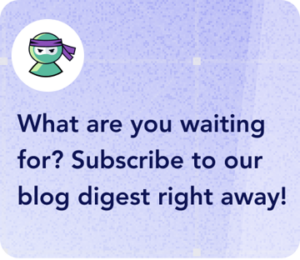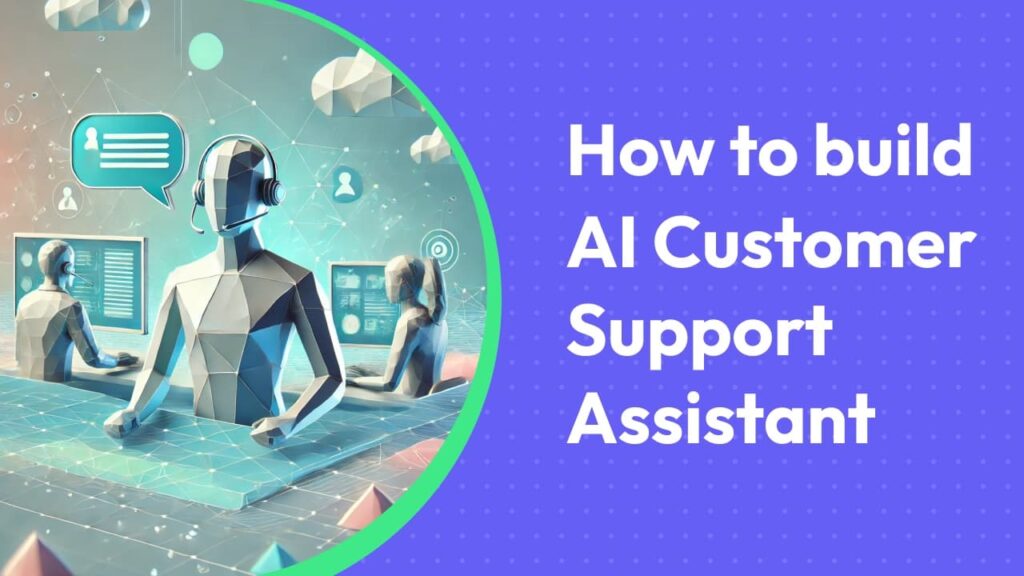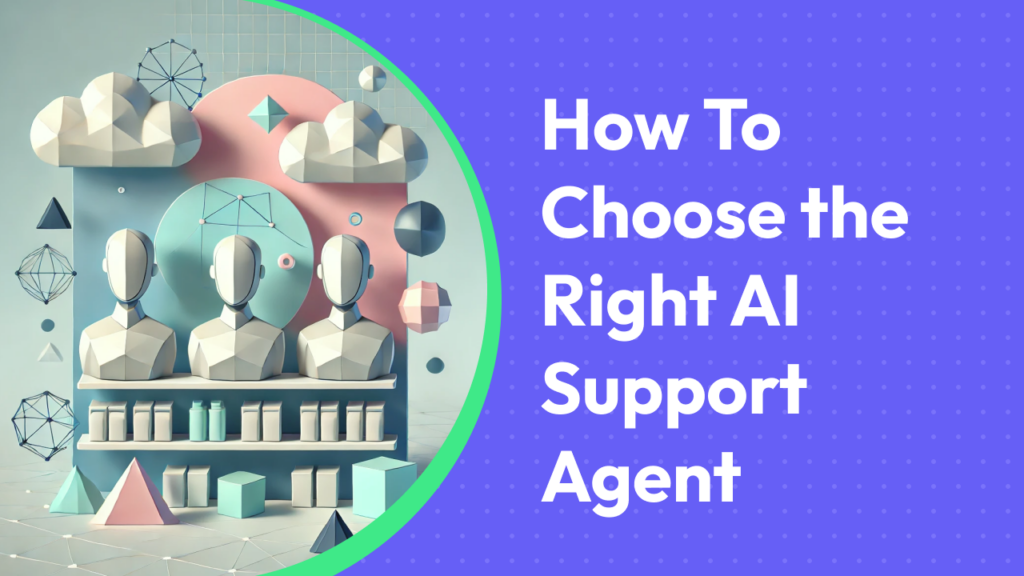- What Is a Chatbot, Really?
- Types of Chatbots [The Smart and the Very Smart]
- How OmniMind.AI Can Transform Your Support
- Step-by-Step Guide on How to Create a Chatbot with OmniMind.AI
- When AI ChatBot Could be Useful
- Conclusion
So, you’re thinking about creating a chatbot. Great choice!
Especially if you’re looking to give your support team a little boost.
We get it—support is a never-ending cycle of answering questions, resolving issues, and, well, trying to make customers happy. But here’s the thing: a chatbot can actually help with all that… and more.
Let’s break down exactly how you can create a chatbot using OmniMind.AI, boost your response rate, and make life a little easier for both your team and your customers.
In this article, we provide:
- A clear understanding of what a chatbot is
- Info on the two types of chatbots
- The business benefits of using such an assistant
- A clear 4-step tutorial on creating a chatbot with OmniMind AI
- Use cases of AI helpers for your support processes
Let’s go?
What Is a Chatbot, Really?
Chatbots have been around for a while—like, 1960s “old-school” while—but today’s chatbots? Totally different ballgame.
Back then, chatbots were pretty basic.
They were programmed to recognize a handful of keywords and respond with pre-written phrases. Imagine talking to a robot that can only say a few things, and none of them quite make sense.
Yeah, not so helpful. But an attempt was made.
Fast forward to today, and chatbots have evolved into sophisticated AI assistants capable of holding full conversations. And we’re not talking about those awkward, repetitive “Did you mean…?” interactions.
Today’s bots—like the ones powered by OmniMind.AI—can understand natural language, context, and even learn from past conversations to make your life easier. They get smarter with time and allow for great personalization, which is believed to be the driving force for businesses.
But before you jump into building your own chatbot, it’s important to understand that not all bots are created equal. There’s a range of chatbot types, from the very basic rule-based bots to the ultra-smart AI-driven ones. And picking the right one depends on what you need it to do.
So, let’s break it down.
Types of Chatbots [The Smart and the Very Smart]
In 2023, 46% of surveyed American companies reported using AI chatbots, virtual assistants, and/or ChatGPT.
What bots can be used?
Pattern-based Chatbots
First up, we’ve got the pattern-based chatbots. Think of these as the “old-school” bots—the ones that have been around since the early days. They operate on a set of predefined rules and patterns.
Here’s how they work:
- Keyword Recognition: These bots scan your message for specific keywords or phrases. If they find a match, they respond with a pre-written reply linked to that keyword.
- Scripted Responses: Their replies are all scripted in advance. If you say something they recognize, they’ll give you the corresponding response. If not, well… they might get a bit confused.
- Limited Understanding: They don’t really understand context or nuance. So, if you ask, “What’s the weather like?” they might respond accurately. But if you say, “Do I need an umbrella today?” they might not make the connection.
Example Scenario:
Imagine texting a customer service bot: “Hey, I need help with my order”
- Bot’s possible response: “Please provide your order number.”
Now, if you say, “It’s not arriving on time,” the bot might not know how to help because it wasn’t programmed for that specific phrase.
The Vibe: Efficient but can feel a bit… robotic. They’re great for handling simple, straightforward queries but might leave users frustrated if they venture off the beaten path.
Learning-based Chatbots
Now, let’s talk about the learning-based chatbots—the super-smart, next-gen bots powered by AI and machine learning. These guys are like the honor students of the chatbot world.
- Artificial Intelligence: They use AI to understand and process natural language, which means they can interpret what you’re saying even if you don’t use specific keywords.
- Contextual Understanding: These bots grasp the context of the conversation. So, they remember previous interactions and can handle follow-up questions without missing a beat.
- Continuous Learning: Every interaction helps them get smarter. They learn from user inputs and improve over time, refining their responses to be more accurate and helpful.
Example Scenario:
You message the bot: “Hey, I’m having trouble with my last order. It’s not here yet.”
- Bot’s possible response: “I’m sorry to hear that your order hasn’t arrived. Could you please provide your order number so I can check the status for you?“
See the difference? It understands the issue without needing specific keywords.
Introducing OmniMind.AI
This is where OmniMind.AI takes things to a whole new level. OmniMind doesn’t just create any learning-based chatbot—it crafts an AI assistant that’s practically indistinguishable from a human.
- Advanced AI Capabilities
OmniMind uses cutting-edge AI to understand not just the words but the intentbehind them. It picks up on nuances, slang, and even emojis! Plus, it can be trained on your own data, allowing it to respond with answers tailored specifically to your business needs. - Easy Integration
You don’t need to be a tech wizard to set it up. With just a few clicks, you can have a chatbot that’s ready to go. And it’s not limited to just your website—OmniMind integrates seamlessly with platforms like Slack, WhatsApp, and more. - Customizable Personality
You can tweak the bot’s “personality” to match your brand voice—be it professional, friendly, quirky, or anything in between. What’s more, OmniMind’s settings are flexible: you can control how much conversation history it remembers for context, decide if it pulls information solely from your database or also the web, and track and refine its responses during training to continually improve its understanding.
Instead of just spitting out pre-programmed responses, OmniMind’s AI-driven chatbots adapt to the flow of conversation. It’s like talking to a real person (almost!).
They can handle complex queries, understand the intent behind a user’s message, and provide relevant solutions on the spot.
And the best part?
You don’t need to be a coding wizard to set it up. OmniMind makes it super simple for anyone to get started.
“Chatbots can be total game-changers. In fact, according to a 2023 survey, about six out of ten U.S. consumers said they love chatbots because they save time—mainly because they’re available 24/7. No waiting around for business hours! Plus, 45% of people mentioned that chatbots’ quick responses were a huge perk, instantly answering their questions without any hassle.”
How OmniMind.AI Can Transform Your Support
Before learning how to create a chatbot for a website or app, see where the magic happens. Creating a chatbot is one thing, but what’s in it for your support team?
Let’s take a quick look at the business benefits OmniMind.AI can bring to the table.
- Cost-efficiency: By automating those repetitive “easy” questions (think: “How do I reset my password?”), your chatbot will take over tasks that usually eat up your team’s time. This frees up your support agents for more complex, human-needed conversations—without needing to hire more people.
- Higher customer satisfaction: Chatbots can be available 24/7, meaning customers don’t have to wait for office hours to get answers. And with OmniMind, you can have self-support pop-ups that guide users to resolve issues on their own, like finding FAQs or troubleshooting common problems. No more “Please hold”—just instant help.
- Boosting response rates: Faster response = happier customers. When your chatbot is handling the front line, response rates skyrocket, and your team isn’t bogged down by repetitive queries. OmniMind can even suggest answers or provide useful resources to customers right away. Efficiency, meet satisfaction.
Step-by-Step Guide on How to Create a Chatbot with OmniMind.AI
So, how do you create a chatbot?
Here’s the fun part! Building your own chatbot on OmniMind.AI is super simple. Let’s walk through it together:
Step 1: Getting started
Create a “Website and Chatbot” AI Agent To begin, navigate to the “Create agent” page and select the “Website & Chatbot” template. This template is designed to help you build an AI-powered chatbot that can interact with your website data and provide automated assistance to your visitors.
The “Website & Chatbot” template offers a pre-built agent structure that you can customize to suit your specific needs. This template is particularly useful for businesses that want to enhance their customer experience by providing instant, personalized responses to common inquiries.

Step 2: Understand the Website & Chatbot Template Summary
After selecting the “Website & Chatbot” template, you are presented with a detailed summary of the agent’s functionality and features. This summary provides an overview of how the template is designed to enhance your website’s customer experience.
The key points to note in the Template Summary are:
Overview of Agent: The Website Chatbot is designed to help website visitors by answering their questions based on the website data and other integrated knowledge sources. It’s perfect for improving customer support and engagement on your site.
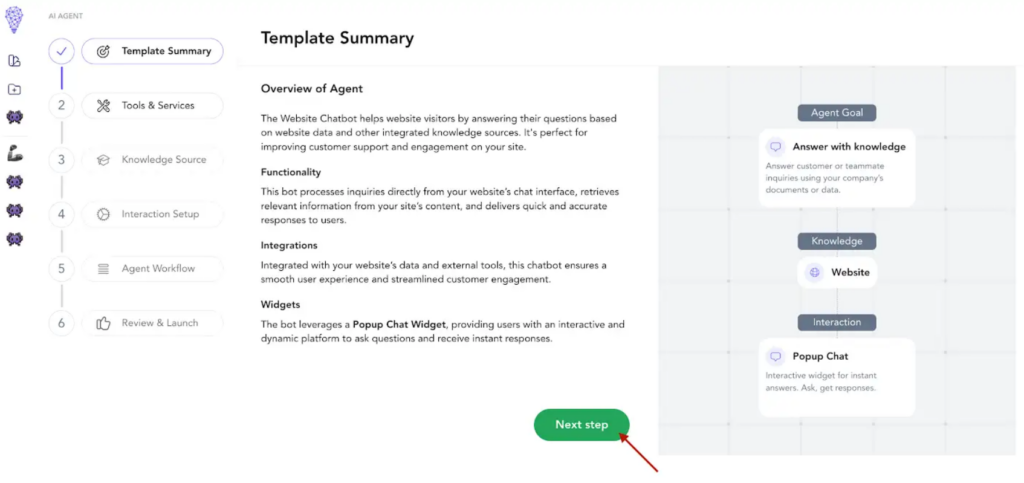
Step 3: Explore and Add Relevant Tools to the AI Chatbot
The “Tools & Services” section provides a wide range of integrations and capabilities that you can add to your AI chatbot. These tools allow you to extend the functionality of your chatbot and integrate it with your existing business systems and data sources.
Let’s go through a few examples of when and how you might use these tools:
Google Calendar Integration:
- By integrating your chatbot with Google Calendar, you can allow customers to easily schedule appointments, check availability, and add events to their calendars directly through the chatbot.
- This can improve the customer experience by providing a seamless way to manage interactions and follow-ups.
Google Sheets Integration:
- Integrating your chatbot with Google Sheets can enable customers to access and update relevant data, such as product information, pricing, or order details, directly from the chat interface.
- This can be particularly useful for customer service or e-commerce scenarios where customers need to retrieve or update information.
Calendly:
- By integrating Calendly, your chatbot can provide customers with the ability to easily find available time slots and book meetings directly within the chat interface. This eliminates the need for customers to navigate to a separate scheduling page, creating a more streamlined experience.

Step 4: In this step, you can configure the knowledge sources and files that will train your AI chatbot.

- Add Links:
- In the “Add Links” section, you can enter website URLs that your chatbot will use to gather information and answer customer queries. This could include your company’s website, blog, or any other relevant online resources.
- By providing these links, you are giving your chatbot access to a broader knowledge base, allowing it to retrieve up-to-date information and provide more comprehensive responses to your customers.
- Upload Files:
- In the “Upload Files” section, you can drag and drop or click to upload various documents that will further enhance your chatbot’s knowledge. This could include PDF manuals, product specifications, customer service guides, or any other files that contain information your customers might need.
- The chatbot will learn from these uploaded files, giving it the ability to provide detailed and accurate responses based on the content of these documents.
Both the “Add Links” and “Upload Files” options allow you to expand the knowledge base of your AI chatbot, ensuring that it can effectively assist your customers with a wide range of inquiries and provide them with the information they need.
Step 5. The Interaction Setup step allows you to configure the specific widget that will be used to facilitate interactions between your customers and the AI chatbot.
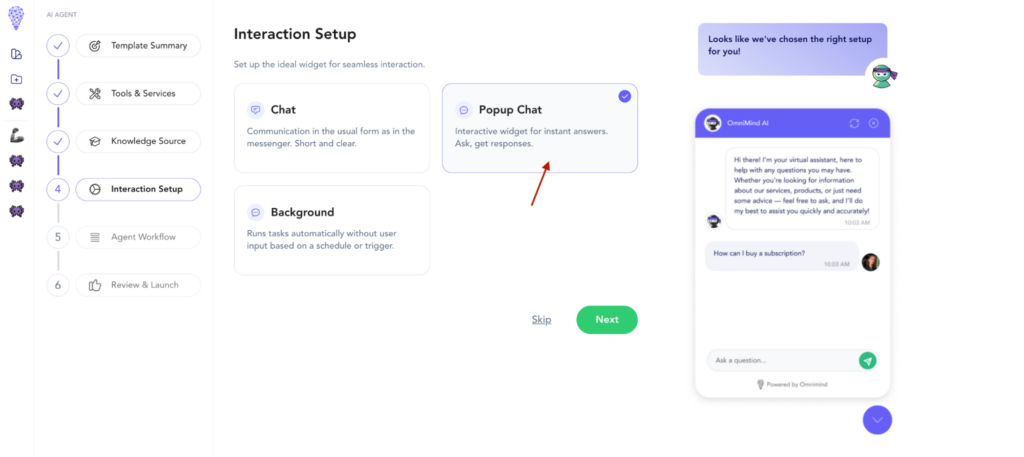
In this case, you’ve chosen to integrate the Popup Chat widget, which is an excellent option for providing a seamless, interactive experience for your website visitors.
The Popup Chat widget offers several key benefits:
- Instant Answers: The Popup Chat feature enables your AI chatbot to provide quick and direct responses to customer inquiries, without the need for them to navigate through multiple pages or menus.
- Engaging Interface: The dynamic, interactive nature of the Popup Chat creates a more engaging and user-friendly experience for your customers. They can simply ask questions and get immediate assistance.
- Contextual Awareness: The Popup Chat widget can be configured to automatically appear based on certain triggers or user actions, ensuring that it is presented to customers when they are most likely to need assistance.
By choosing the Popup Chat option, you’re empowering your AI chatbot to have meaningful, real-time conversations with your website visitors, ultimately enhancing their overall experience and increasing the chances of successful outcomes, whether that’s answering questions, providing support, or driving conversions.
Step 6. The Agent Workflow outlines the core process your AI chatbot will follow to engage with users and provide helpful responses.
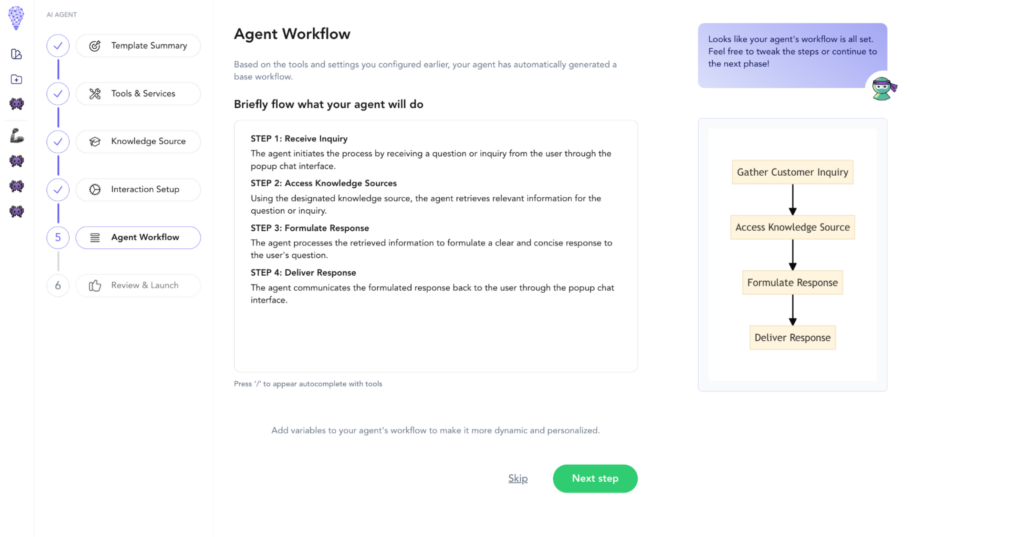
Here’s a step-by-step breakdown:
- Receive Inquiry
- The chatbot receives the user’s question or inquiry through the Popup Chat.
- Access Knowledge Source
- The chatbot retrieves relevant information from the knowledge sources you provided, such as your website content and documents.
- Formulate Response
- The chatbot processes the information and crafts a clear, concise response to the user’s question.
- Deliver Response
- The chatbot communicates the response back to the user through the Popup Chat.
This default workflow ensures a smooth and efficient interaction between your customers and the AI chatbot. You can further customize this workflow by adding variables or tools to make the experience more personalized and dynamic.
Final Step: Almost there! Finalize the configuration of your AI chatbot before deploying it.

Here’s what you need to do:
- Agent Name: Provide a descriptive name for your AI chatbot, in this case, “Omnimind Website Chatbot”.
- Agent Overview:
- Agent Type: This is set to “Knowledge” since your chatbot is focused on providing information and answers.
- Answer with Knowledge: This is set to “None” since you haven’t added any specific knowledge sources yet.
- Interaction Widget: This is set to “Popup Chat”, as you selected earlier in the setup process.
- Final Review: Before launching your chatbot, double-check that all the necessary tools and integrations have been properly configured. Fill in any missing credentials to enable all the chatbot’s features.
Once you’re satisfied with the setup, click the “Launch” button to make your AI chatbot live and available to your website visitors.
Remember, you can always come back and make changes or additions to your chatbot’s configuration as needed. The key is to get it up and running now, and then continue to refine and improve it over time based on user feedback and your evolving business needs.
When AI ChatBot Could be Useful
OmniMind.AI doesn’t just stop at creating chatbots.
It’s here to completely upgrade your support game, no matter what industry you’re in. But since we’re zooming in on support today, let’s explore how your team can really make the most of OmniMind’s features.
- Pop-up Chatbots for Self-Support
Ever visited a website, and a chatbot just pops up, asking, “Need help with something?”
That’s a pop-up chatbot in action— and it could be your support team’s secret weapon. With OmniMind’s AI assistant, this pop-up feature isn’t just for show. It’s an interactive guide that helps customers solve problems themselves, 24/7.
How does it work?
OmniMind’s AI scans your website’s content and offers relevant suggestions based on what the user might need.
For example, if a customer is browsing your product page, the bot can pop up with commonly asked questions about delivery times or returns. It’s like having a support agent on call, but without the added manpower.
Plus, pop-up chatbots allow customers to self-navigate through their issues.
Need to check on an order?
Troubleshoot a product?
The bot can guide users to the right page, helping them find the answers they need—instantly and independently. This not only reduces the burden on your support team but also improves the customer experience by eliminating wait times.
- Instant Responses to FAQs
Now, let’s talk about those repetitive questions that your team gets all the time. You know the ones: “What’s your return policy?” or “How do I reset my password?”
Imagine freeing up your support agents by letting a chatbot handle these FAQs for you—automatically and instantly.
With OmniMind.AI, you can train the bot to pull answers directly from your FAQ page, troubleshooting guides, or even your internal knowledge base. The bot becomes your first line of defense, responding to common queries in seconds.
Customers no longer have to dig through pages of information or wait for an agent to get back to them. The right answer is served up immediately, and you save your team hours of manual work.
“And here’s the best part: OmniMind’s AI doesn’t just repeat answers blindly. It learns from past interactions and provides personalized responses based on the customer’s history. If someone has asked a similar question before, the bot remembers and can tailor its response to be even more helpful the next time around.”
- Seamless Escalation to Human Agents
Let’s be real—there are times when a chatbot just can’t handle it all. Maybe the issue is too complex, or the customer needs a personalized touch. That’s where OmniMind really shines with its seamless escalation feature.
When the chatbot reaches the limit of its capabilities, OmniMind makes it easy to hand over the conversation to a live human agent. The transition is smooth, and the customer doesn’t feel like they’re starting from scratch.
The bot passes on all the relevant information—like the customer’s previous questions, any troubleshooting steps they’ve already tried, and even, potentially, their mood—so the human agent can pick up right where the chatbot left off.
This hand-off is crucial for maintaining customer trust and satisfaction. No one likes having to repeat themselves or start a conversation over. OmniMind ensures that when a human agent takes over, they’re fully informed and ready to solve the problem quickly and efficiently. And even if it’s outside business hours, the bot can still acknowledge the issue and assure the customer that help is on the way first thing in the morning.
- Use Cases for Sales
OmniMind.AI isn’t just for support—it’s a powerhouse for sales teams too.
Chatbots can engage potential customers from the moment they land on your website, guiding them through the sales funnel with personalized recommendations and real-time interactions. Here’s how:
- Lead Qualification. OmniMind can act as your first point of contact, asking qualifying questions to understand a prospect’s needs and sorting leads based on readiness to buy. This means your sales team only gets the hottest leads, saving time and boosting conversion rates.
- Product Recommendations. Using customer data and previous interactions, OmniMind’s AI can suggest tailored product recommendations. For example, if a customer has been browsing a specific category, the chatbot can recommend similar or complementary products, nudging them toward a purchase.
- Instant Support During Checkout. Sometimes, customers hesitate at the checkout phase. OmniMind can jump in with immediate support—whether that’s answering questions about shipping options, offering discount codes, or providing quick solutions to technical issues that might otherwise lead to cart abandonment.
- Use Cases for Healthcare
In the healthcare industry, timely responses and personalized care are crucial. OmniMind.AI can revolutionize the patient experience while reducing the strain on healthcare staff. Here’s how:
- Appointment Scheduling and Reminders. Patients can use OmniMind to schedule appointments in real time, directly through the chatbot, without needing to call or wait on hold. The bot can send out automated appointment reminders or follow-ups, ensuring patients never miss a critical visit.
- Symptom Checking and Triage. OmniMind can be set up to perform initial symptom checks based on patients’ inputs. This allows healthcare providers to triage cases, ensuring that urgent issues are escalated to medical staff, while more routine queries are handled by the chatbot.
- 24/7 Patient Support. For non-emergency inquiries, OmniMind can provide around-the-clock support. Whether it’s answering questions about medications, offering advice based on common symptoms, or providing information on healthcare services, the chatbot is always available. This frees up healthcare professionals to focus on more complex cases while ensuring patients still feel supported.
Conclusion
By now, it’s clear that chatbots aren’t just a trendy tech tool—they’re a powerful solution for improving customer support and overall business efficiency. With OmniMind.AI, you get more than just a chatbot.
You get an AI assistant that works tirelessly around the clock, ensuring your customers get the answers they need, whenever they need them. Whether it’s offering pop-up support, handling repetitive FAQs, or smoothly escalating complex issues to human agents, OmniMind transforms the way you interact with your customers.
And the best part?
You don’t need to be a tech expert to set it all up.
With OmniMind’s easy-to-use platform, you can create and customize your chatbot in just a few simple steps, making sure it’s perfectly tailored to your business’s needs.
So, if you’re ready to boost your support response rate, cut down on costs, and give your customers the seamless, personalized experience they expect, it’s time to get started with OmniMind.AI. Your support team—and your customers—will thank you for it!

How useful was this post?
Click on a star to rate it!
Average rating 5 / 5. Vote count: 7
No votes so far! Be the first to rate this post.

